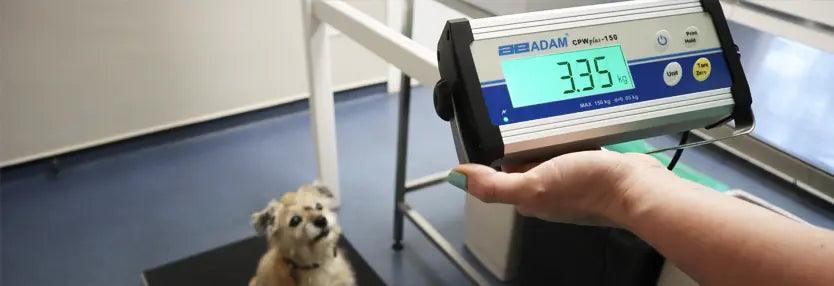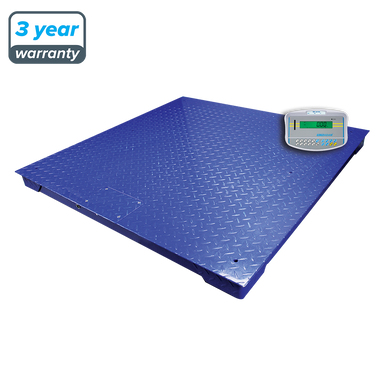
How to Weigh Animals Accurately Using the Hold Function
Your furry friends may need to be weighed for a variety of reasons, but above all, it helps to make sure they’re healthy. But what if your critter is not too keen on staying still while they’re weighed? That’s okay, the handy hold function is there to help. This blog will discuss what the hold function is, how to use it to weigh animals accurately, and which animal scales with Hold features we recommend the most.
Understanding the Hold Function on Weighing Scales
The hold function on weighing scales enables you to freeze the result on the display, so it will remain even after removing the weight from the scale. This allows you more time to record results, which can be especially helpful when dealing with a moving animal that’s trying its best to wiggle off the weighing pan. Why is it so important to get accurate results when weighing animals? See our blog, Vets: Why Accurate Animal Weighing is Important.
Some of the animal scales that we offer on Inscale have multiple options for setting the hold function. The first option is setting the hold function so that it activates automatically, once the scale stabilises after adding your pet on the scale, or after a certain amount of time has passed. This can be great for convenience, but if the weight is likely to fluctuate at all as the animal moves and adjusts, it might be better to go with option two. Option two is setting the hold function so that it activates manually, that way, when you’re satisfied that the scale has reached the most correct result, with your animal settled as much as possible and the scale stabilised, you can physically press the Hold button to freeze the display.
Preparing for Accurate Animal Weighing
To make the process as smooth and accurate as possible, it’s a good idea to prepare a few things in advance before weighing any animals.
The number one most important preparation to make is selecting the proper weighing scale for the job. The same scale that’s big enough to weigh a St. Bernard isn’t likely to provide the best weighing results for a hamster or a Bearded Dragon. If you’re weighing pets at home, you’ll just need one scale suitable for the pet you’ll be regularly weighing. If you’re a veterinarian, you’ll likely need multiple scales of varying sizes to accommodate your whole clientele.
Pre-calibrating your scale before weighing is another preparation that will help guarantee accurate measurements, as you’ll be certain that the scale is working at tip-top shape. Making sure your scale has a regular calibration check is always recommended – we suggest at least once every 12 months – and will help guarantee accurate measurements. You should also make sure that the scale is on a flat, level surface because any additional wobbling besides that from the animals will impact the weighing results.
In general, it may save time to have a blanket or container nearby that you can place on the scale to make a nervous animal more comfortable and less likely to jump off – just remember to Tare it off before weighing! Finally, every animal appreciates a treat for a job well done.
Step-by-Step Guide: Weighing Animals with the Hold Function
- Prepare the animal for weighing, removing all unnecessary collars or harnesses that may impact the weight reading.
- If you have the choice, set the way you want the hold function to operate – automatically, or manually.
- Place the animal on the scale. If you’ve set the hold function to be automatic, the display will freeze as soon as the result is stable, or after the set amount of time. If the hold function is manual, when you’re satisfied with the displayed weight, press the Hold button to freeze the display.
- Remove the pet from the scale.
- Record the weight frozen on the scale.
- Re-zero the scale so it’s ready to use next time.
Recommended Animal Scales with Hold Functions
Adam MTB Portable Animal Scale

Capacity: 20kg
Readability: 5g
The MTB Portable Animal Scale is ideal for small dogs, cats, rabbits and other compact companions. The MTB features a curved weighing pan to cradle each pet, which can be removed to reveal a flat pan with a non-slip rubber mat underneath. The scale’s rechargeable battery makes the MTB portable, so it can be used wherever it’s needed. The MTB has an auto-hold feature, which will freeze the results for enough time to allow you to store the weight in the MTB’s memory bank or record it.
Adam CPWPlus S Small Animal Scale

Capacities: 6kg – 15kg
Readabilities: 2g – 5g
The CPWPlus S Small Animal Scale is a portable, easy-to-use weighing scale with a separate indicator and base, which allows you to place the display wherever is convenient, such as on a wall at eye level. The stainless steel weighing pan resists scratches and is easy to clean should things get messy.
Adam CPWPlus M Veterinary Scale and Adam CPWPlus L Large Animal Scale


The CPWPlus M and L Series are the second and third steps up in size from the CPWPlus S, with the M offering a 500mm x 500mm stainless steel platform and the L offering a 900mm x 600mm stainless steel platform. Both series feature a rechargeable battery and splashproof indicator for easy portability and cleaning. All three CPWPlus models offer multiple hold options, including the ability to set a timer on when the weight will freeze on the display.
Adam PT Platform Scale & GK Indicator

Capacity: 1 tonne – 3 tonnes
Readability: 200g – 500g
Maybe you weigh large animals, like livestock at a farm, and need an extra rugged and durable platform scale to survive the great outdoors. With mild steel platforms as big as 1500mm x 1500mm, the PT can handle rough environments. With the separate, mountable GK indicator, you can keep track of whether animals are healthy weights by using the checkweighing feature, which lights up when the weight is above or below certain limitations.
Need help deciding which animal weighing scale is for you, or setting up the hold feature? Get In Touch with the Inscale team.

Leave a comment